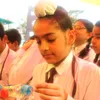Workshops, panels, exhibitions: how the Bengaluru ByDesign Festival 2019 delights viewers with art and design
In this two-part photo essay, we feature a range of creative works from BbDF 2019, along with artist and designer insights on transformative change in society.
Launched in 2014, PhotoSparks is a weekly feature from YourStory, with photographs that celebrate the spirit of creativity and innovation. In the earlier 405 posts, we featured an art festival, cartoon gallery. world music festival, telecom expo, millets fair, climate change expo, wildlife conference, startup festival, Diwali rangoli, and jazz festival.

Founded by arts and culture manager Suprita Moorthy, the second edition of the Bengaluru ByDesign Festival (BbDF) is back with 10 days of workshops, panels, and exhibitions in venues across the city. See Part I, Part II, and Part III of our coverage of the 2018 edition, as well as our d.Zen section on design.
The Bangalore International Centre features a range of creative works by Liz West, Jane Withers, Anupama Kundoo, Vitek Skop, Jakub Szczesny, John Gollings, Mariel Manuel, and designers from JD Institute and Pearl Academy.
Other venues of BbDF include Titan Campus, Workbench Projects, and CoWorks (Residency Road). The programme is about the layering of stories, not just installations but the talks, education, the conversations that take place around it, according to Suprita Moorthy.
There are workshops on 3D printing, design thinking, wire weaving, leather craft, and mobility design. A range of panels addresses the future of architecture, inclusivity in arts festivals, design of products for accessibility, and trends in home design.
Mariel Manuel has been working in Paris for a number of fashion houses for the past decade, and designed the installation with upcycled material called Garbage Dreams. “I can definitely say "sustainable" has become more like a trend rather than a reality in fashion,” she says, but stresses that we need to go beyond trends to make sustainability a reality.
“The location of the installation in the BIC balcony is also very beautiful, there is wind blowing through the textiles, and it makes it alive and connected to the elements. There are eagles flying above. I like this connection,” she explains.
Mariel was invited to BbDF via Pro Helvetia in New Delhi, and is on a three-month residency. She will giving a workshop next at AOD in Colombo, and is working on a range of side projects. Her works can priced at € 300 for a painting or € 3000 for a dress.
“Success for me is having the courage to keep walking my path and exploring what I feel I need to explore. Success is having opportunities to share what these findings are. And the biggest success is if I can inspire others to become seekers and walk down their own road,” Mariel explains.
“I think art and design are everywhere around, and maybe it's the seeing that should be improved,” she says. Mentors can play an important role in illuminating passion and even changing lives. “We just have to give people the right keys to understand their potential and possibilities,” Mariel says.
“Art speaks when you are open to receive. And art is everywhere. It is in the most respectable galleries and museums, but it is around every day. How you approach life is how you approach art,” Mariel explains. She advises aspiring artists to dig deep inside themselves, and reveal and nurture the unique gems that are hidden.
Over the past five years, Liz West has been commissioned for artworks be leading institutions and festivals in the UK and elsewhere in Europe. “I grew up with both my parents working as artists, and so have never known a world without art,” she explains.
“I feel art in all its forms is crucial to the enjoyment of life. As an artist, I feel a great deal of responsibility to make work that people can enjoy, as I want them to be transported out of the everyday and into the extraordinary,” Liz says.
The inspiration for her site-specific installation (Our Colour Reflections) was based on her research into luminous colour, colour theory, and light fields. The BbDF organiser saw her works at last year’s Dubai Design Festival, which led to an invitation to come to Bengaluru.
“I hope that the work will encourage a sense of self-awareness among viewers through the reflections and a sense of wellbeing, joy, discovery, and meditation when viewing and immersing oneself in the experience of the work,” she says, describing her exhibit at the festival.
“Festivals are crucial is providing an open platform for artists and designers around the world. The short duration and fast-paced nature of a festival mean that people flock to visit when the artist is present, therefore allowing for relationships to be fostered,” Liz explains. Festivals thus bring people together in unexpected ways.
She regards the London Design Festival as one of her favourites. As trends in art and design, she points to collage in sculptural form, and the use of house plants in interior decoration, retail, public spaces, and art.
Liz conducts workshops in colour theory as well. “I learned colour theory before I could read, thanks to my artist’s parents and have seen the benefit of this throughout my life,” she recalls. She is now planning her next exhibitions in the US, Italy and China.
Success for her is not just being able to practice fulltime or win awards and deals, but in making a lasting impression on the audience. “Success is educating people through your work and enabling people to question why. It is having a wide reach to art audiences and beyond, across all cultures, religions, backgrounds, and identities,” Liz explains.
“More pop culture figures should embrace or bring art into the mainstream. Beyoncé and Jay Z filming their music video in the Louvre increased visitor figures tenfold,” she suggests. Making art accessible by encouraging audience participation in the creation of the work is another example, as in the case of Anthony Gormley’s ‘Field’ exhibition.
Liz sees the creative mindset as the connection between art and design. “I believe the two are interchangeable skills,” she says.
“Art and design are the abilities of a human being. I would say art captures the essence and design refines the form. It is a way to immortalise the past and predict the future,” explains Debabrota Das, Assistant Professor at Pearl Academy, Mumbai.
The Academy’s exhibition at BIC (By Bengaluru) was to intended to engage the people of Bengaluru to express their candid thoughts about themselves and the city. “The idea also explores the context of creating the contemporary history of Bengaluru,” Debabrota adds.
A similar social experimentation by Pearl Academy was done in Mumbai during the Kala Ghoda Arts Festival (KGAF) in 2019. “The idea is to take it as a measure to establish interactive spaces in different cities,” Debabrota says.
He calls for arts and design to be incorporated in the basic education system of India. “Today, we need creative thinkers who can think into the future and lead productivity and efficiency,” he explains.
Debabrota sees sustainability as a major trend in design. His other projects include research on ways to generate critical thinking via design education, and planning an installation for KGAF 2020 (see YourStory’s coverage of the festival’s editions in 2019, 2018 and 2017).
He advises audiences to “build a visual vocabulary which comprises of form, space, colours, and concepts” to enable better appreciation and interpretation of art. As tips for aspiring artists, he suggests that creativity has no end or boundary.
“However, creativity without individuality is a mismatch. So, I would say be creative and be yourself,” Deobrata signs off.
Now, what have you done today to stop in your busy schedule, and find ways to tap the real designer or artist deep within you?



















Got a creative photograph to share? Email us at PhotoSparks@YourStory.com!
See also the YourStory pocketbook ‘Proverbs and Quotes for Entrepreneurs: A World of Inspiration for Startups,’ accessible as apps for Apple and Android devices.









